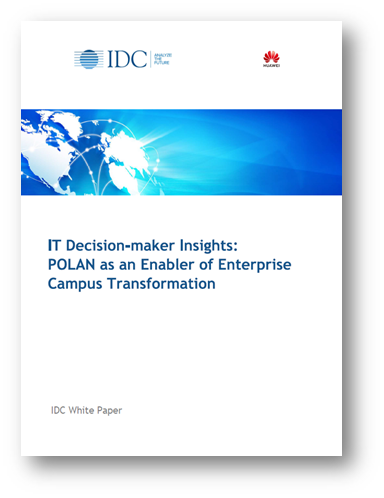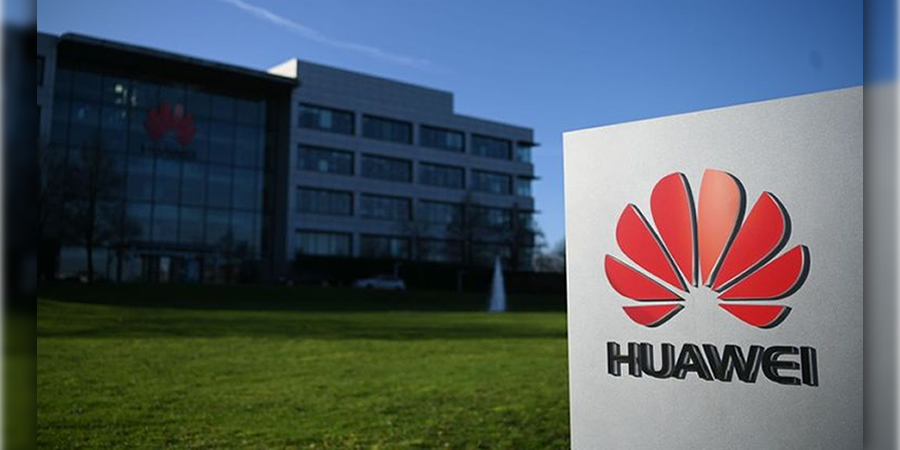During HUAWEI CONNECT 2020, Huawei released a White Paper titled IT Decision-maker Insights: POLAN as an Enabler of Enterprise Campus Transformation. According to the White Paper, IT decision makers are rethinking their campus network strategies as digital transformation speeds up as a result of the COVID-19 pandemic.
Compared with conventional solutions, the passive optical LAN (POLAN) solution offers advantages in terms of bandwidth, O&M, power consumption, and total cost of ownership (TCO). In the next five years, POLAN will be widely used across various industries and become a solid foundation for reimagining enterprise services.
The white paper's findings are based on a web survey with IT decision makers at 318 large- and medium-sized enterprises in select countries across multiple industries, including education, government, healthcare, transportation, and real estate. The custom survey was commissioned by Huawei, and was designed, conducted and analyzed by IDC. It provides detailed policy reference and guidance for the construction of enterprise campus networks in the digital era.
The White Paper was designed and conducted by IDC
Enterprises around the world are embracing new technologies such as cloud computing, Wi-Fi 6, big data analytics, and the Internet of Things (IoT). As a result, network traffic is increasing significantly, and traditional enterprise networks, which are difficult to upgrade, and can no longer meet service requirements. According to the white paper, the campus network solution preferred by enterprises must feature a simplified network architecture, simple management, low cost, and flexible capacity expansion to meet future requirements.
The white paper also shares four reasons why POLAN will become a mainstream campus network solution in the context of digital transformation, detailed below.
In the near future, HD videos and IoT applications will grow exponentially, and continuously push up bandwidth requirements. Compared with copper cables, optical cables provide higher bandwidth and capacity, and support continuous bandwidth upgrades without re-cabling. For example, the Dubai Creek Harbor has adopted the POLAN solution to carry hotel IoT and video services based on the 10G PON technology, meeting their requirements projected for the next 10 years. The technology and bandwidth can be upgraded without replacing the transmission media, thereby protecting customer investment.
Compared with traditional copper cables, fibers feature low latency, high reliability, and anti-electromagnetic interference. This enables fiber lines to meet the requirements of new campus applications such as video conferencing, security surveillance, AR/VR interaction, and IoT. A national bank has adopted the POLAN solution in its office building to modernize its office network and carry all services, including wired office, digital enhanced cordless telephone (DECT) voice, wireless AP backhaul, and IoT access.
Compared with traditional campus network solutions, the POLAN solution has a simpler architecture. Only OLTs need to be managed. Terminals support plug and play, and faulty terminals can be directly replaced, greatly reducing the O&M workload. In addition, passive splitters replace a large number of active aggregation devices, reducing the possibility of faults. Fudan University has adopted the POLAN solution as part of its efforts to build a smart campus with a simplified architecture and minimal cable deployment. The solution simplifies fault locating and capacity expansion, and reduces the O&M cost.
The POLAN solution reconstructs the campus network from multi-layer to two-layer. As the network structure is flattened, fewer IT equipment rooms are required, and the power consumption of devices and equipment room ventilation is effectively reduced by 30%. A famous hotel in Yunnan China adopted the POLAN solution for this purpose, revolutionizing their network infrastructure. Thanks to long-distance transmission and multi-service bearing, the network supports Wi-Fi, voice, HD TV, and hot spring intelligent control, sparing the need for hundreds of equipment rooms. The annual power consumption is reduced by 100,000 kWh, equivalent to 47.5 tons less carbon emission or 2,065 more trees planted.
Not only is fiber capable of providing better services, it has obvious physical advantages in size, weight, and capacity expansion capability. According to the IDC survey, customers agree that POLAN can be deployed and operated more easily and efficiently, and reduce the CAPEX by around 20%.
Rohit Mehra, Vice President of IDC, said: "As more data collection and analysis tasks are increasingly pushed to the enterprise edge, campus networks become a solid foundation for enterprise service innovation. More and more enterprises will look favorably at POLAN solutions to leverage latest technologies for an improved user experience, increase service revenue, and to speed up digitization."
Jinhui Wang, President of Huawei Transmission & Access Marketing Execution Dept, also provided his opinion on the solution: "The result of this in-depth survey accurately reflects the expectations of enterprise IT decision makers for campus network construction. We believe that in the next few years, the POLAN solution will be rapidly deployed in many industries, including education, hotel, and transportation. Huawei will continue to invest in solutions and industry ecosystem construction to enable ubiquitous optical connections."










